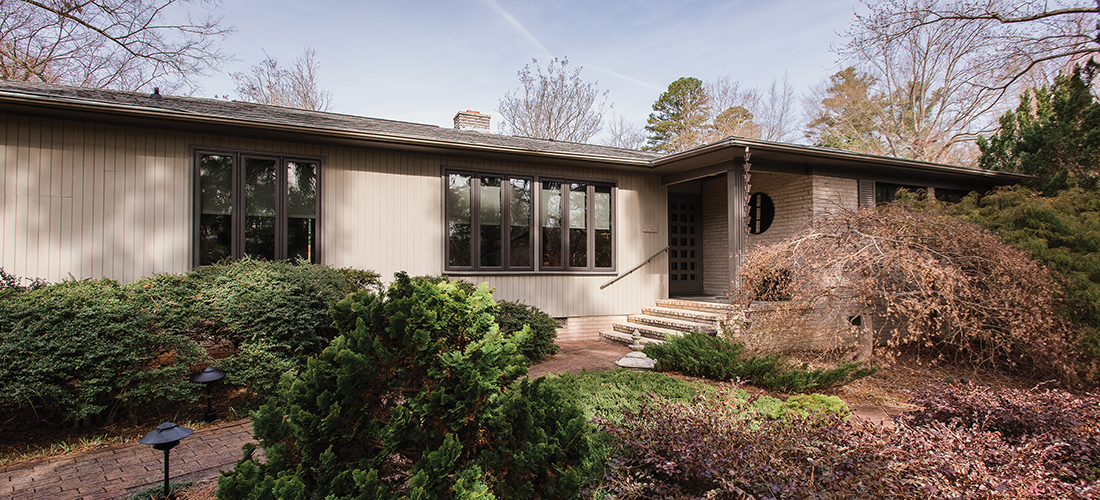
Lee and Bill Britt’s Japanese-inspired retreat echoes with the cycles of life
By Jim Dodson • Photographs by Amy Freeman
Daffodils are in bloom but snowflakes dance in the air on the chilly mid-March afternoon Lee Britt greets a visitor at her front door facing Green Valley Road.
“It’s always like this in March, isn’t it?” Britt says with a musical laugh. “It’s like we are between seasons!”
Discreetly hidden from street view behind two longleaf pines and a trio of magnificent Cryptomeria (Japanese cedars), the charming mid-century, bungalow-style wood and stone house the Britts built in 1968 from plans Lee clipped from the News and Record’s lifestyle pages, is the result of a half century of thoughtful living and Lee Britt’s evolving fascination with — and spiritual connection to — Asian culture.
This becomes even more apparent in the tidy foyer of the house, where slate underfoot, a silk wall hanging from the Asian Art Museum of San Francisco and the handiwork of Seagrove master potter Ben Owen III, among others, make the entry feel a bit like stepping into a Kyoto teahouse — complete with a view of the garden. The hues are earth-toned, muted and invitingly intimate. Light seems to stream from several sources; straight ahead an elegant Asian-style window frames a vignette of Britt’s spectacular backyard, inviting the eye up a meandering pebble and stone pathway that symbolizes a tranquil stream. It winds to the rear of the property to a focal point, an earthen red torii gate commonly found at the entrances to Shinto shrines in Japan.
The effect is remarkable: a spacious sense of life flowing into nature, a sudden feeling of peace and unity one feels even before seeing the rest of a modestly sized house that seems much larger than its 2,200 square feet. When her visitor comments on this fact, she smiles and confirms, “That’s nice to know. I’ve had people say that before — especially my garden club, which likes to hold meetings here.”


Britt breaks the spell “That [window] was originally supposed to be a large circular window like you find throughout the Far East. But when our builder was doing the big renovation here in 2006, he drew a peace symbol in the circle I’d placed on the wall, causing me to think that might be a little too pretentious.”
In the next breath, she is quick to point out that both the house and garden, with their unmistakable references to Eastern simplicity and style, are not specifically Japanese. “I prefer to think of [them] as Asian, featuring elements that are common to many Japanese gardens and houses — my interpretation of them, at least. It’s been a fun evolution for me, to see it all come together and change over time.”
At the time Bill and Lee Britt purchased the last lot available on Green Valley Road and began building in 1968, most of the houses around the Britts in Starmount Forest — still newlyweds — were traditional brick affairs with classic Southern details.
“But I wanted something different, something very contemporary, clean and simple,” she explains. “At that time I really didn’t know much about Asian design principles of home and garden. I just knew what I liked,” Lee explains. “They more I learned about the importance and care the Japanese put into sense of home and place, and certainly their gardens, the more I was drawn to their concepts. I’m really self-taught. Nature is all about evolution, isn’t it?”
For the Britts, this process began in earnest when they expanded their garage into a sunroom in the early 1980s. “We had two teenager girls and needed the room for them to have their friends over. Teenage boys have large feet,” she says with her ever-ready laugh. “They needed somewhere to place their feet.”
About that same time, Lee joined the Tar Heel Garden Club, the Guilford County Horticultural Society and Greensboro Beautiful, volunteering for projects that enabled her to absorb knowledge and ideas from local gardening icons like Irene McIver, Jeannette Windham and Dr. Graham Ray.
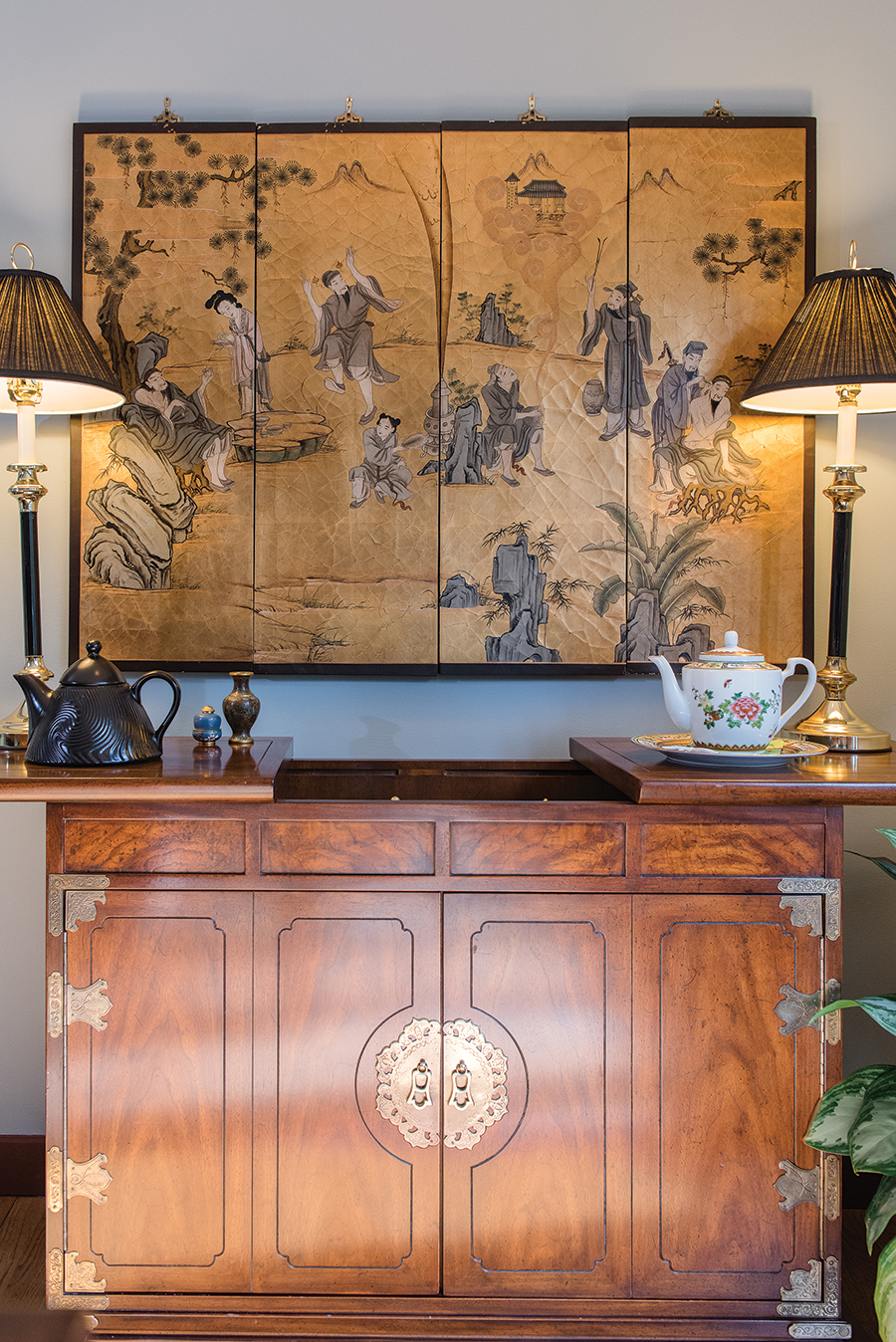
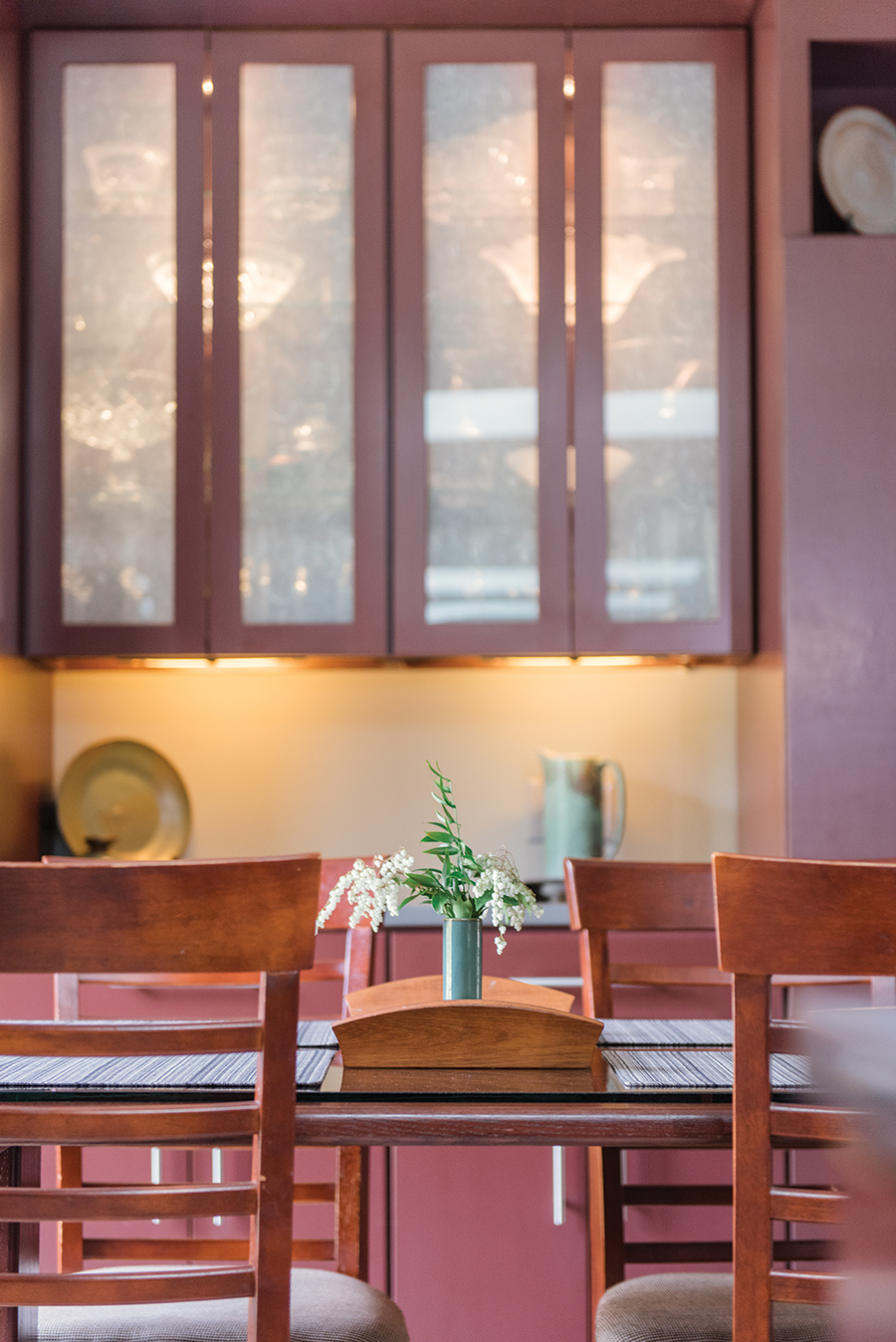
“Jeannette and Mrs. McIver knew everything about gardening. They were really the first of many mentors I’ve had in Greensboro. I knew so little, to begin with. But I was fortunate to have the opportunity to listen and learn directly from them,” Lee says. “That’s where it all really took off for me — the desire to create my own house and garden in Asian style. That’s what gardeners do. They share plants and knowledge and learn from each other, and each other’s gardens.”
It was during this period that Bill Britt, who ran the Gate City’s sports programs for Parks and Recreation for 33 years, collaborated with McIver, Windham and others to create the Greensboro Arboretum and Bicentennial Garden, ultimately overseeing the creation of three major public gardens that came to define Greensboro’s love affair with the natural world. Lee Britt had a hand in creating the city’s fourth public garden — Gateway — following Bill’s retirement.
Something of a Greensboro icon for transforming the city’s various sports programs into a national model, Bill Britt joined Parks and Recreation straight out of NC State in 1959. At that time Greensboro boasted 66 youth teams in four sports. By the time he retired in 1992, there were more than 1,200 teams representing 11 different sports. Among his many notable accomplishments, Britt played a major role in creating the Spencer Love Tennis Complex and the golf courses at Bryan Park.
He also served on the national board of directors of Pony League Baseball, a post that carried him to Japan to represent the organization in 2004, allowing Lee — newly elected chair of Greensboro Beautiful — to tag along and explore some of the finest pubic and sacred gardens of Tokyo and Kyoto, the country’s fabled garden city.
“One of the pluses of spending my married life sitting on bleachers,” she says half in jest, “is that wherever we went to see games, I was able to see gardens and meet gardeners. We did this all over America. The trip to Japan, however, was very special, really the culmination of things I’d been learning and picking up on my own study of Japanese culture and gardens for years. I picked up lots of ideas and inspiration.”
“I don’t think she missed a garden,” Bill chips in with a chuckle.
“That’s true,” Lee allows. “But it’s the peaceful quality and strong connection to nature that I find so appealing in their traditional houses and gardens. If it’s authentic, that sort of thing just comes to you. It’s all about natural elements found in nature — stone, water, trees and shrubs.” She catches herself and smiles. “I love tree bark.”
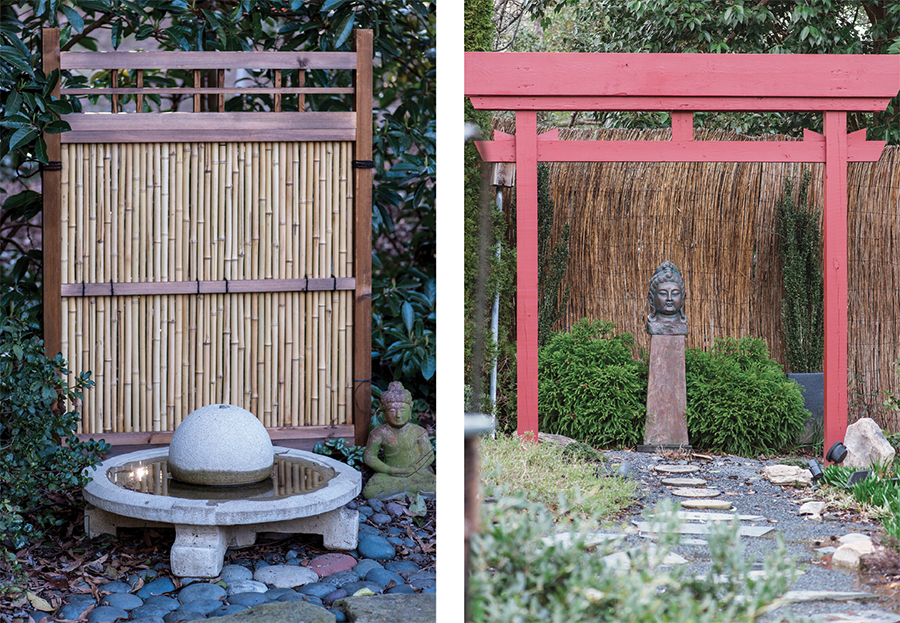
As she says this, music with an unmistakable Asian influence filters gently through the Britts’ great room. An invitingly calm and open space done in soothing tones of muted browns and grays, it is the result of a significant house renovation the Britt’s undertook upon their return from Japan.
In 2006, father-son builders Bob and Scott Richardson incorporated Lee’s ideas into reality by flipping the traditional living spaces, removing a major wall and creating the great room that “flowed” beautifully into the kitchen and small dining area overlooking the garden.
Where their sunroom and former garage formerly existed, the great room took shape with oversized windows overlooking the back garden. Anchoring the south end of the room, a wall of custom-built birch cabinetry by local craftsman Pete Williams, stained a rich burgundy red, provided shelves for displaying books, artwork, pottery and other Asian treasures the Britts have collected from their many journeys.
Tucked discreetly around a corner, meanwhile, sits perhaps the only laundry room in the Triad that features an Asian shoji screen door. “We actually found that at Home Depot,” Lee explains with her beguiling laugh.
Simplicity and practicality also shaped their expanded dining room, a beautiful gathering place done in the same soothing tones of earth and sky, with a formidable Hurtado table, handcrafted in Spain, as a centerpiece, and Henredon buffet with Asian screens. At the south end of the room is a reading nook with a cozy leather chair.
“Our family is rather large and everyone comes at Thanksgiving, at least 30 people,” Lee explains. “The larger dining room really solved a problem for us.”
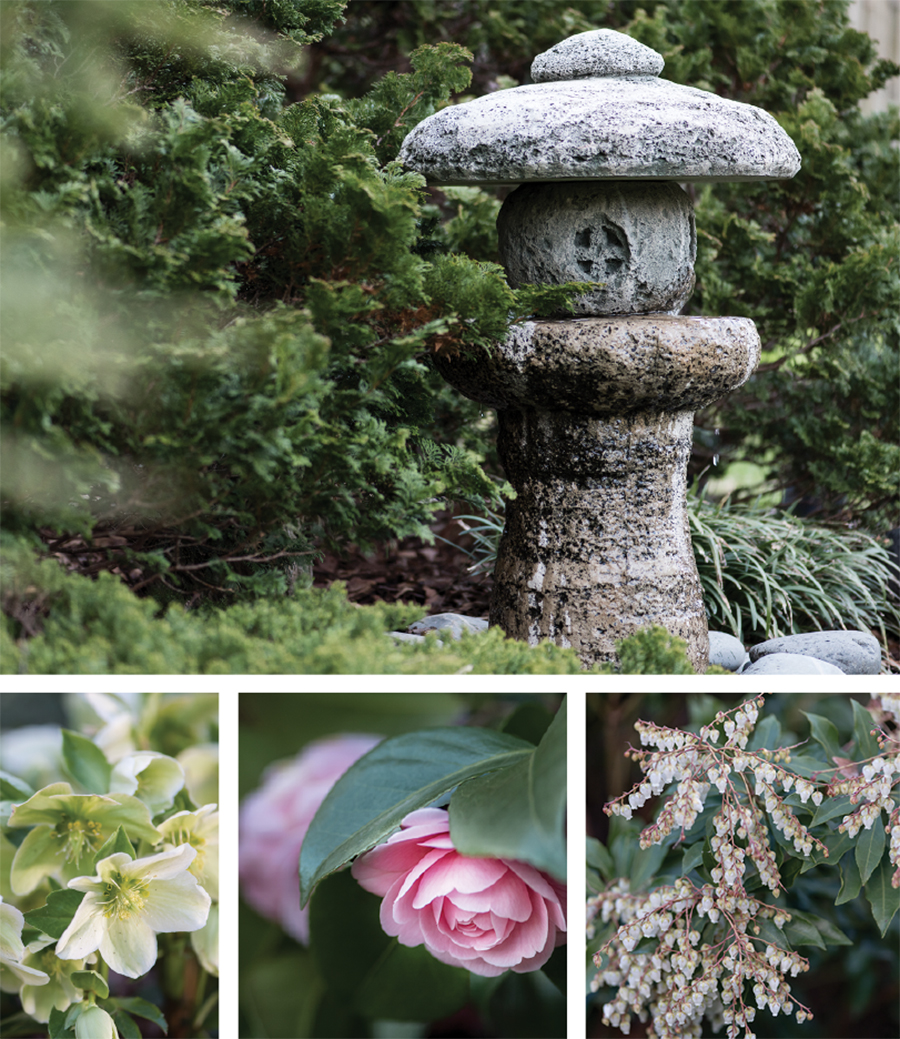
Three basic design principals anchor the foundation of traditional Japanese gardens. The first has to do with intimacy with nature, a connection that copies rather than creates something new. Or as famed Japanese garden designer Shiro Nakane once told Architectural Digest, his goal is “not to make a new nature but to make a copy of existing, desirable nature.”
Since most Japanese gardens are traditionally contained in smaller spaces, the landscape becomes a living metaphor for the world beyond, its natural elements scaled to reflect this symbolism. Streams replicate rivers, rocks stand in for mountain ranges, and winding gravel pathways are roads through a peaceful world in miniature.
Finally, quite often one finds Asian gardens enclosed by fences or conifer surrounds, becoming sanctuaries meant to inspire one to step away from the hubbub of daily life, a spiritual retreat that is never complete and forever changing, a reflection of nature itself.
These are some the ideas Lee Britt had in mind when she began her garden and half a lifetime ago, eventually growing it into a cozy paradise that is Asian in influence that is hers alone.
On a walking tour as the snowflakes still dance, she relates intimate stories of how her garden took shape — how the twin longleaf giants out front have somehow survived years of winter storms, reciting both the Latin and common names of mugo pines, Japanese hollies, yews, camellias and ground covers that are just awakening to Carolina spring.
At the top of her driveway, where a trio of large cherry trees, pink azaleas and hostas are about to rise and burst into bloom, a small iron Eastern symbol stands guard.
“What does that mean?” asks her visitor.
“I believe it simply means good luck.”
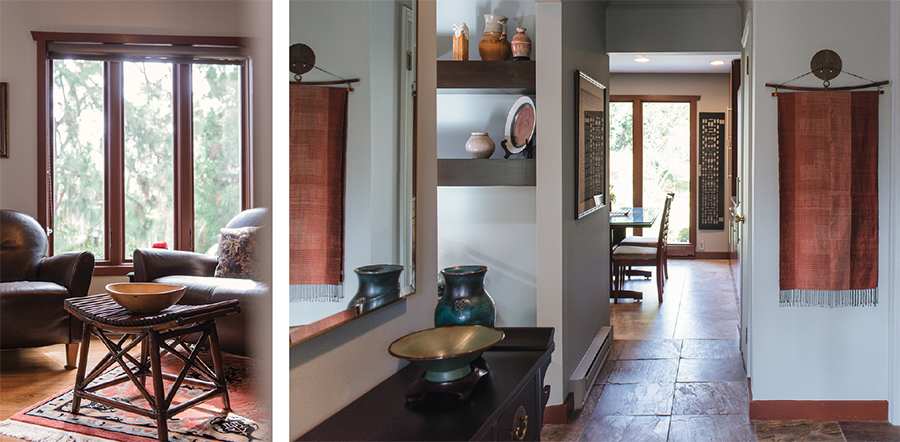
On the nearby deck stands a collection of garden gnomes, a congregation of tiny figurines that represent a beautiful story of remembrance and continuity in this peaceful household.
In 2011, the Britt’s son-in-law, Will Caviness, a Greensboro firefighter, collapsed and died while running in the Chicago Marathon on behalf of the International Association of Fire Fighters Burn Foundation that helps burn victims.
“It was devastating. Will was such a vibrant young man, seemingly in the peak of good health,” Lee relates, smiling at the gnomes. “He loved to tease me by placing gnomes in my garden where I’d find them in the oddest places. Once, while we were attending the Christmas Eve services, he put an illuminated Santa on our roof. That was Will. Such a wonderful guy.”
The city of Greensboro, she adds, as the garden tour continues, “wrapped their arms around our daughter Jenny and their children, Jack and Caroline, who continue this tradition today. They love to show up when we’re not here and hide these gnomes in the garden. It’s such a lovely way to remember their father.” At a young age, their third grandchild, Elizabeth, announced that someday she planned to buy this house and garden of earthly delights.
Following the pebble and stone “stream” that winds serenely around and through her Asian garden, the story of life and death and rebirth flows on. One learns about the large sweet gum that a storm toppled onto a 40-year-old wax myrtle, requiring the garden keeper to change out shade plants for sun-loving perennials; about the benches and stone borders she built herself; the old fashioned “Pink Perfection” japonica she took from her mother’s garden on a tobacco farm in Creedmoor, and so forth. Every planting has its own life story, including the twin crab apple trees, the false yews and a large summer perennial bed that will achieve its glory in mid summer.
“You’ll have to come in June to see it because it has everything — phlox, salvias, rosemary, sedums. . .” she pauses and laughs again. “Goodness, everything. It’s always changing. Come see.”
And at the end of the day, that is the beauty of the house and garden that the family Britt has made, a personal sanctuary from the madding world beyond the trees, a loving balance between east and west, sunrise and sunset, death and rebirth and endless new beginnings in the natural world that is their home. OH
The peace of Jim Dodson’s own Asian-inspired garden has been disrupted by the rapacious Star of Bethlehem that has overrun his garden beds.





